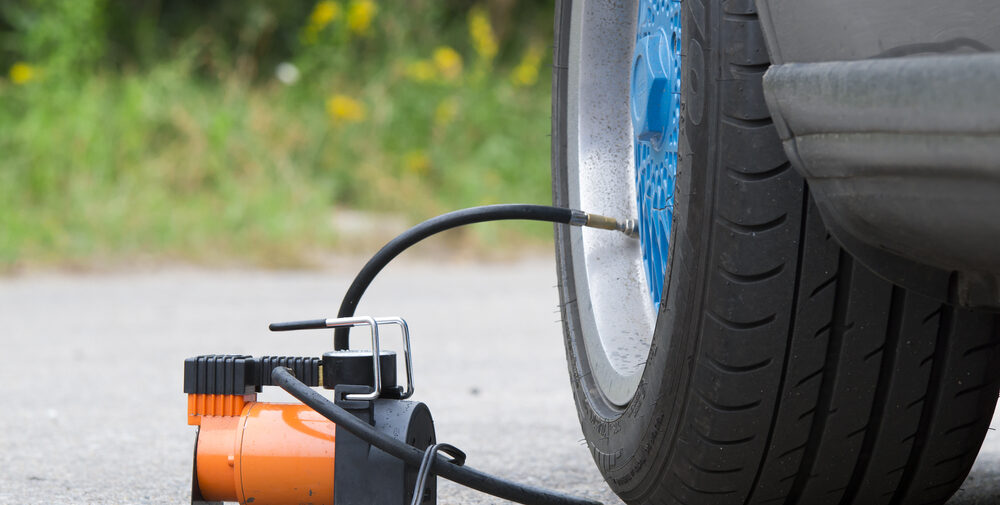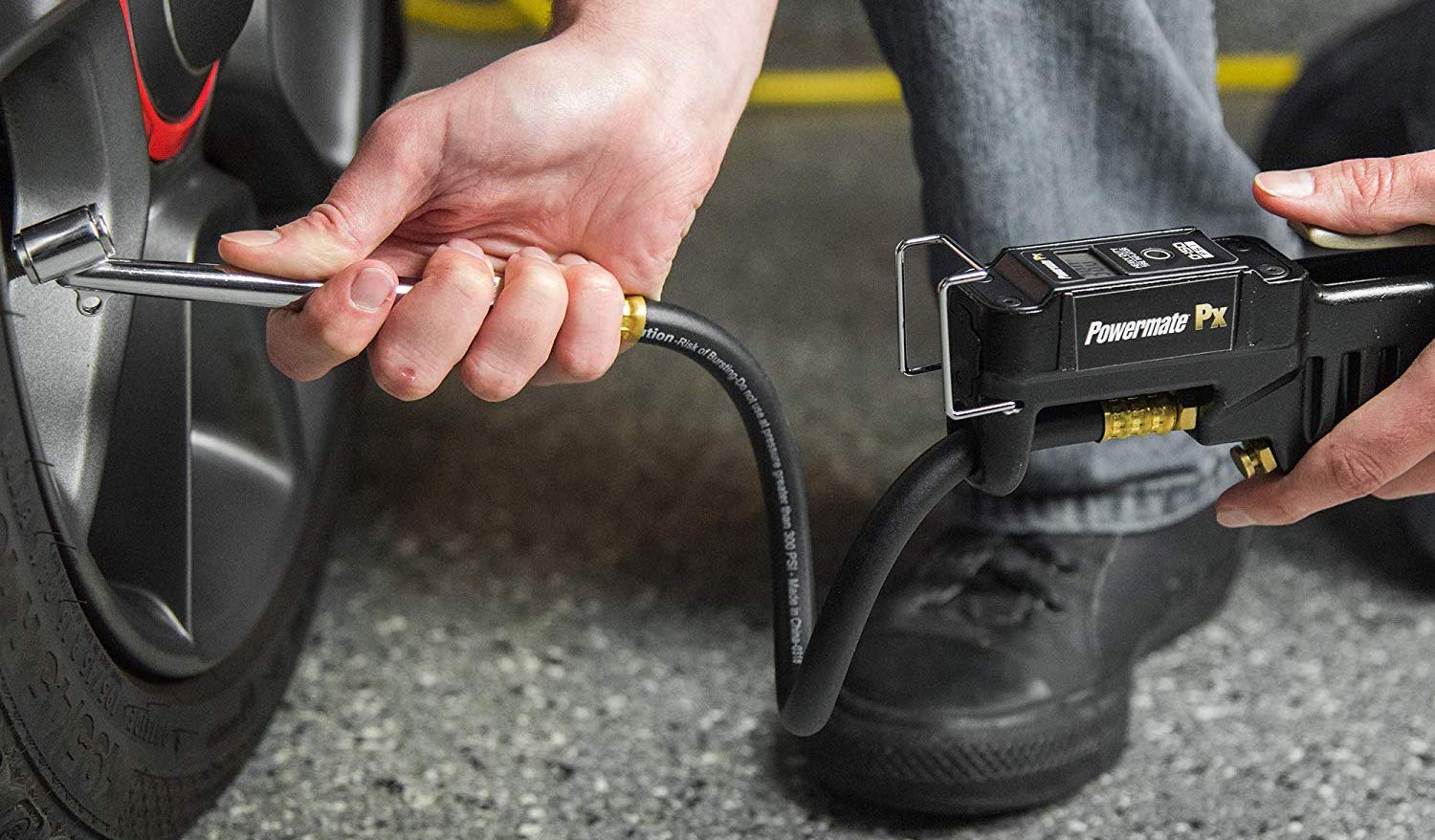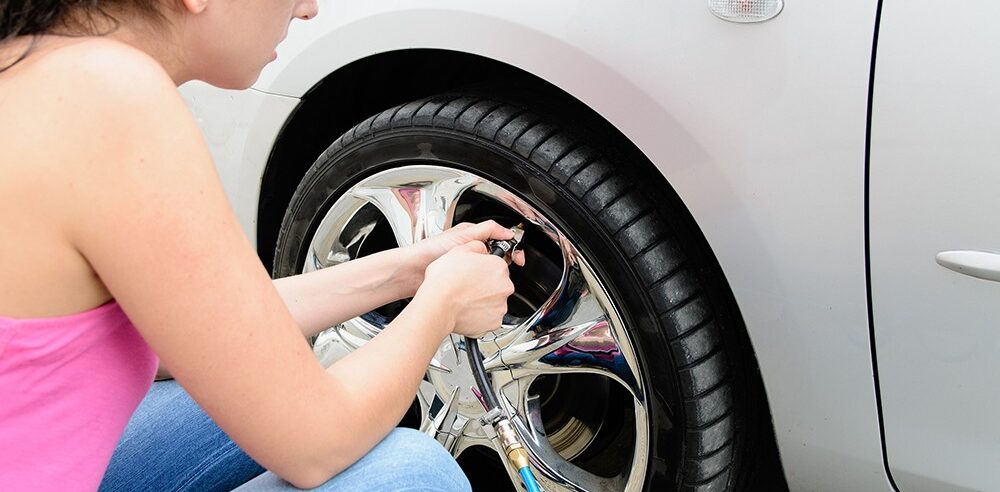Pumping up a wheel is not difficult in urban areas. You can always go to the gas station to air pump up your tires, but what if you have a flat tire while driving, on a highway through a desert, or even at home? As a result, it’s crucial to have an air compressor on hand and be familiar with using it.

How to use an air compressor to air up a car wheel is still a relevant query. The majority of drivers use electric pumps. But a car owner might be perplexed by the use of a compressor. You will learn everything about how to use air compressor to inflate tires in this article, including how much air pressure the tire needs to be filled with.
Contents
What is a car compressor?
Simply plug the power cord into the cigarette lighter and then press the toggle switch on the compressor. Everything should work.

The automobile compressor for inflating wheels is an electric motor with a piston and a cylinder. To supply power to the electric pump motor, a long wire with a plug is used. The design of plug is designed for quick connection to the cigarette lighter socket.
Types of air compressors for automobiles
You should become acquainted with the most common types of automotive compressors before beginning. Since it’s crucial to understand the features of various models. Pistons, membranes, and rotaries make up the three main types of compressors, according to their mode of operation.
Piston compressor
The most common choice is the piston compressor. Devices of this type operate on an incredibly straightforward principle that somewhat resembles the internal combustion engine’s mechanics.
Reciprocating air compressors use two valves.
The first of these releases air during the piston’s main stroke and the second is required to supply air to the cylinder during the pusher’s reverse motion.
Membrane compressor
Its size and metering are small, and it operates quietly. They are made entirely differently. Their working principle is also quite straightforward: the working rod moves the rubber plate by deforming it using a unique cam mechanism.
In turn, the air inside the closed cavity to which this plate is adjacent starts to compress and then rushes under high pressure into a special outlet air hose.
The suction of air is carried out through the inlet pipe as a result of the closing of the exhaust valve during the reverse movement of the stem.
Rotary compressor
When high performance is required, to inflate car tires for SUVs and trucks, a different type of compressor called a rotary compressor is typically used. Such a device’s operation is based on the use of a unique rotor in the construction. As a result, performance is extremely high.

However, they have some drawbacks, including a relatively short working life, large mass and dimensions, and the need for routine maintenance. Even though this type of compressor operates well and quickly, it is not very common.
Know your car’s characteristics
Knowing your vehicle’s characteristics before you get into an accident will help you be ready for any repairs or adjustments. These general characteristics could be included in this knowledge:
Proper tire inflation
Find out the recommended tire pressures your car needs for the best performance before you flat tire. PSI, or pounds per square inch, is the unit of air pressure most frequently used for automobiles. While 30-35 psi is generally the recommended tire pressure for modern vehicles, we advise you to check the owner’s manual provided by the tire manufacturer.
Use a different desired pressure instead of the pounds per square inch indicated on your tire sidewalls.
This PSI, which is used to indicate the highest air pressure your tires can support, may be deceptive. By using this measurement, you and your car run the risk of tire explosions and possible harm.

Tire pressure monitoring systems (TPMS) have been standard equipment on the majority of cars since 2008. When the tire pressure falls below 25% of the recommended psi, this system warns the driver.
Temperature
Air pressure in vehicles is typically measured at lower temperatures by the majority of auto manufacturers. Because heated car tires expand, lower temperatures are preferred. The PSI value is increased by this extension.
Wheel inflation rules
To inflate tires correctly, it is important to know the type of device power supply. Both the cigarette lighter socket and the battery can be used to connect the compressor power cable to the vehicle’s internal network.
The device’s instructions ought to make note of this.
If you’re unsure, take a look at the wire. The cigarette lighter is the only connection method offered by the majority of inexpensive models. More expensive models have a cigarette lighter socket and a car battery connection on the same wire, allowing two different types of connections.

Typically, compressors that are powered by a battery have more power. These models are more effective and productive.
Procedure for inflating tires:
- Remove the air compressor from the protective cover and use it;
- Install next to a flat tire;
- Unscrew the stem cap from the tire valve stem and put the air hose tip on the fitting;
- Put the stem cap somewhere safe;
- Take the plug and connect the hose to the cigarette lighter;
- To push air into the valve stem, go back to the wheel and turn on the air compressor’s toggle switch.
- Inflate a tire
- Once the necessary pressure has been attained, shut off the toggle switch;
- Remove the compressor by going backward;
- From the tire valve stem, unscrew the stem cap.
Tire pressure gauge
Many car owners know how important it is to constantly monitor tire pressure. To inflate your tires to the optimal value depends on:
- Adhesion of the projector tire to the road surface;
- Handling and obedience of the car on the road;
- Tire wear;
- Fuel consumption;
- Stopping distance;
- Driving safety;
- Safety of the suspension and body elements;
- The size of the contact patch with the road;
- Driving comfort, the presence/absence of noise in the car, softness, etc.
To find out what is the correct tire pressure, a tire gauge will help. The device, which is not built into the air compressor, has a very compact size and can easily fit not only in the glove compartment but also in a woman’s handbag. A tire gauge can tell you how much-compressed air your tires need to have added.

Some tire gauges will come with a flat stick you can use to press down on the valve stem pin. It does not matter which tire pressure gauge you prefer – analog or digital tire pressure gauge, the main thing is to have this device at hand and use it regularly to measure tire pressure.
Both types of instruments are easy to use and give fairly accurate readings. But unlike a digital tire pressure gauge, an analog one is always ready for use and does not depend on built-in batteries.
How to use a tire’s pressure gauge to check the pressure in your tire?
- Park your car.
- Once the tire valve stem has been removed, the stem cap should be stored in a safe place.
- Make sure there is no air leakage by pressing the tire gauge firmly against the valve stem.
- On any available display, take readings.
- To increase the accuracy of the outcomes, repeat the procedure two to three times.
What to do if the tire pressure is very low?
You will need to drive your car at least a short distance to the closest gas station if you find yourself in a situation where you have low tire pressures and nowhere to inflate your tires.
In this situation, make sure to:
- Take the shortest route possible.
- To avoid tire wear and damage, drive very slowly.
- Reduce the amount of weight you transport in your vehicle by unloading any heavy items you can.
- Use an air compressor to inflate your tires as soon as possible to the recommended PSI.
Tips
- You now understand how to use an air compressor to ply tires. Here are some typical errors that prevent people from performing this work themselves or giving tires the best care possible:
- Never drive with under-inflated or punctured tires, unless it is essential.
- Inflate your tires to the proper tire pressures at all times (check correct tire pressure at least once per month) to maintain consistent performance.
- A running air compressor should never be left unattended.
- Check the owner’s manual provided by the tire manufacturer settings.
- Verify that all of your equipment, including the air compressor, tire valve, power outlet, and tires, is compatible.
Warnings
- The pressure gauges that come with some gas station air compressors may not be accurate due to improper handling. Consider using your air gauge if at all possible.
- Avoid putting too much air in the car tire than what your car requires. On many vehicles, the recommended tire pressure is typically close to explosive levels at 40 psi or more.
- Do not go over the suggested levels by more than 5 psi for safety’s sake.
- Consider overfilling each car tire (according to the air gauge on the air distributor) for safety, given the limited time, the air pump has available. When you’re finished, get your tire gauge, check the pressure in each tire, and, if necessary, release some air.
- Sometimes an air gauge, which is made of metal with an etched marking, is found at the end of the air hose. Reading in this style at night can be challenging. Bring your reliable tire gauge.
- To inflate your tires should be done with caution. The handling and ride comfort of a tire can be negatively impacted by excessive pressure as well as increased wear on the tire’s center. A tire that has insufficient pressure may flex excessively, overheat, and burst. High-center-of-gravity vehicles, like SUVs, may roll over as a result of this.
- Additionally, inadequate pressure results in increased tire wear and energy waste (significantly lower gas mileage). Please be aware that car tires typically have a higher maximum pressure than what the vehicle indicates. Don’t give in to the tire pressure.
- When pumping air into the tire, it is best to avoid leaning on the top of the tire. Even though it’s unlikely for a tire to blow at a slightly higher pressure than advised, you should still avoid hitting the top to prevent harm.
- To avoid over-inflating a bicycle tire and possibly bursting the tube, add air in smaller increments when using a high-pressure air compressor (such as one found at a gas station).
- While working on car tires (and generally any automotive parts), it might be a good idea to take off any necklaces and any hanging jewelry or objects.
FAQs
Can you use a portable air compressor to inflate tires?
Portable air compressors will do if you just need a quick and simple way to fill up your car, bicycle, or wheelbarrow tires. Small, portable compressors—also known as air inflators—have gained popularity as a convenient way to inflate a variety of car tires, sporting goods, and other inflatables in garages at homes.
What PSI should I set for my air compressor for tires?
Most automobiles, crossover SUVs, and pickup trucks have relatively small tires that properly inflate to the recommended air pressure of 32 to 36 PSI. However, larger tires, like those on RVs, farm machinery, and service vehicles, frequently require up to 100 PSI.
How do you use an air compressor for the first time?
It is advisable to perform a test run before using an air compressor for the first time. The pressure power switch should first be turned to “off.” Connect the power supply. Turning the air compressor “on” will now start it. The pressure gauge ought to increase gradually. Now switch it “off,” remove the power cord, and let out any trapped air in the tank.
What is a tire chuck?
Pneumatic tire chucks connect to the stem or hose of a tire pressure gauge, inflation, or air compressor. The tire chuck holds the airline to the tire valve stem so that air can flow freely between the tire and the tool used to check, inflate or deflate the tire.
Final thoughts
An air compressor is a valuable addition to your arsenal of tools with which you can air pump up flat tires. But if you’ve never bought an air compressor at an auto parts store before, this might seem like a pretty intimidating machine. But don’t be afraid – using an air compressor is easier than you think!


